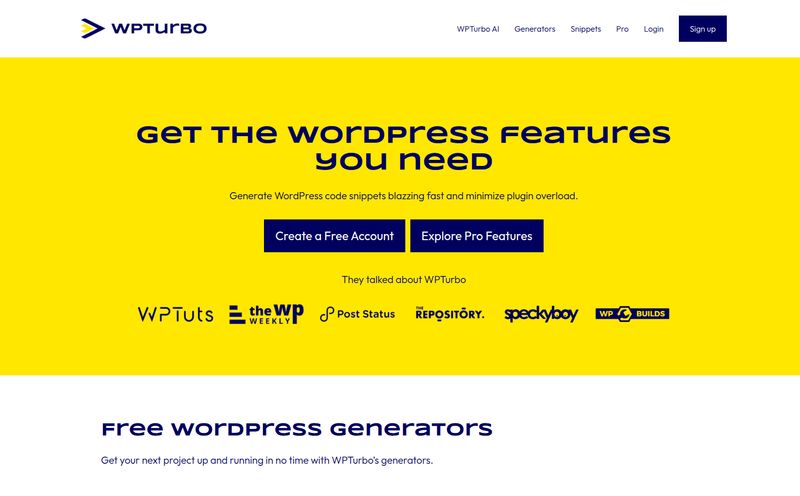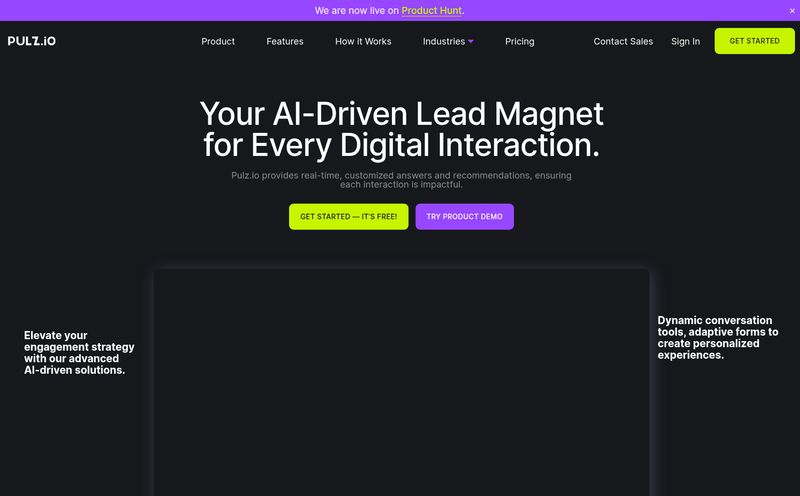Alright, let’s have a real chat. If you’ve been in the web development or design game for more than five minutes, you know the dance. The designer pours their soul into a pixel-perfect Figma file. It’s beautiful. It’s intuitive. It’s a masterpiece. They hand it off to the developer, who smiles, nods, and then immediately starts sweating, because turning that static beauty into living, breathing React components is a whole other beast.
I’ve seen this movie a hundred times. The back-and-forth emails. The Slack messages with a dozen screenshots. “This padding is 2px off.” “Can this button have a slightly different hover state?” It’s a bottleneck that can grind a project to a halt. For years, we've been promised tools that would automate this process, creating a magical bridge between design and code. Most, frankly, have been underwhelming. They spit out messy, unusable code that takes more time to fix than to write from scratch.
So, when I heard about a tool named Bifrost, I was skeptical. But the name... it's clever. In Norse mythology, the Bifröst is the rainbow bridge connecting Earth to the realm of the gods. The metaphor is clear: a bridge from the realm of designers (Figma) to the realm of developers (React). Cute. But does it actually work?
I decided to take a closer look, and what I found was... surprisingly promising.
What Exactly is Bifrost? (And Why Should You Care?)
At its core, Bifrost is an AI-powered tool that automatically converts your Figma designs into clean, functional React code. Think of it as a hyper-intelligent translator. You show it a picture (your Figma design), and it writes the description (the React code) for you. Just... poof. No more manually building out every single div, setting every style property, or wiring up basic component structures.
This isn't just about saving a few keystrokes. It's about fundamentally changing the workflow. The idea is to slash the time engineers spend on mind-numbing UI grunt work, freeing them up to focus on the complex logic, API integrations, and all the other fun stuff that actually makes an application work.

Visit Bifrost
For designers, it’s a promise of empowerment. Instead of just handing off a design and hoping for the best, you can make changes in Figma, hit a button, and see those changes reflected in the actual codebase, often without even needing to bother an engineer. It’s a pretty exciting proposition.
How Bifrost Changes the Game for Devs and Designers
So where does this tool really shine? I've been poking around, and a few things stand out as genuine game-changers, not just marketing fluff.
Bridging the Gap: No More Lost in Translation
The single biggest win here is design consistency. The tool reads your Figma file—your component library, your spacing tokens, your color palette—and uses it to generate the code. This means the final product in the browser is far more likely to be a 1:1 match of the design file. This alone eliminates countless hours of tedious back-and-forth and pixel-pushing adjustments.
What's more, it creates a living connection. When the marketing team decides the primary brand color needs a slight tweak (we’ve all been there), the designer can update it in the Figma library, and Bifrost can sync that change to the code. No more manually hunting down every instance of `#5A4FCF` and replacing it. This is a huge deal for maintaining and scaling a design system.
The Need for Speed: Rapid Prototyping and Iteration
In today's agile world, speed is everything. Bifrost acts like an accelerant for your development cycle. Need to spin up a new landing page for a campaign? Design it in Figma, convert it with Bifrost, and you've got a functional React page ready for content and logic in a fraction of the time it would take to build from scratch. This is massive for startups and lean teams who need to iterate quickly and test ideas without a huge upfront investment in engineering time.
I can see this being incredible for building out internal tools or dashboards, too. The kind of projects that need to be functional but don't always get the same level of UI polish time as a flagship product. This lets you get a good-looking, consistent UI off the ground almost instantly.
Speaking the Lingo: Tailwind and Chakra Support
This was a big one for me. One of my main gripes with older tools was the generic, often inline-styled CSS they produced. It was a nightmare to manage. Bifrost's support for popular frameworks like Tailwind CSS and Chakra UI is a massive vote of confidence.
It means the code it generates isn't some weird, proprietary mess. It's idiomatic, utility-class-based code that a modern frontend developer can actually read, understand, and extend. It plugs right into an existing development ecosystem, which lowers the barrier to adoption significantly.
Let's Be Real: The Potential Hiccups with Bifrost
Okay, I'm not going to sit here and tell you it's a magic wand that solves every problem. As with any tool, especially one powered by AI, there are trade-offs and limitations. And being aware of them is what separates a happy user from a frustrated one.
A Bit of a Learning Curve
Bifrost isn't for absolute beginners. To get the most out of it, your designers need to be pretty disciplined with Figma. That means using auto-layout correctly, structuring frames logically, and building proper components. A messy Figma file will lead to messy code. Garbage in, garbage out, as they say.
On the other side, a developer still needs to be a developer. You need to know React to take the generated code and turn it into a fully-featured application. This tool handles the 'view' layer, but the logic is still all on you.
The AI's Limitations: Code Quality and Complexity
This is the big one. For standard layouts—cards, forms, navbars, hero sections—the generated code is often impressively clean. But what about that wild, asymmetrical, animation-heavy design your creative director just fell in love with? That's where you might see the AI stumble.
The code quality can vary with the complexity of the design. Think of the AI as a very talented, very fast junior developer. It can build out the structure perfectly based on the blueprint, but it might not handle the really nuanced, tricky parts with the grace of a seasoned senior dev. For highly customized or complex components, you should expect the generated code to be a starting point, not the final product. You'll likely need to go in and refactor or add your own custom touches. Which is still better than starting from a blank file!
So, Who Is Bifrost Actually For?
After digging in, I have a pretty clear picture of who gets the most value out of a tool like Bifrost:
- Startups and Agencies: Teams that need to build and iterate on MVPs at lightning speed. The ability to go from design to a working prototype in hours, not weeks, is a competitive advantage.
- Teams with Established Design Systems: If you've already invested in building a robust component library in Figma, Bifrost can be the engine that automates its translation into a React component library.
- Frontend Developers Who Hate CSS: Let's be honest, they exist. For devs who love building logic but find UI implementation tedious, Bifrost is a dream. It lets them offload the visual layer and focus on their strengths.
- Product Teams: It allows for faster validation of ideas. You can build out a high-fidelity prototype that is not just a picture, but actual code, making user testing far more realistic.
What's the Damage? A Look at Bifrost's Pricing
This is the million-dollar question, isn't it? As of my writing this, Bifrost hasn't published a clear, public pricing page. This is pretty common for tools that are either in a late-stage beta or are targeting enterprise customers with custom plans. My best advice is to head directly to their website (I've linked it below) and see what the current status is. They might have a free tier for small projects or a trial you can sign up for to see if it fits your workflow.
Frequently Asked Questions about Bifrost
- Does Bifrost replace frontend developers?
- Absolutely not. It's a tool for frontend developers. It automates the repetitive parts of their job, allowing them to focus on more complex tasks like state management, API integration, and performance optimization. It's an assistant, not a replacement.
- What kind of code does Bifrost generate?
- It generates React code. Crucially, it supports popular styling solutions like Tailwind CSS and Chakra UI, which means the code is clean, modern, and easy for other developers to work with.
- How does Bifrost handle design updates?
- This is one of its coolest features. Designers can make changes in Figma, and Bifrost can sync those updates to the code. This keeps the design and the live application consistent without a manual handoff process.
- Is the generated code 100% production-ready?
- It depends. For simple, well-structured designs, it can be very close. For more complex or highly custom designs, think of it as an excellent, high-quality starting point that a developer will then refine and build upon.
- Do I need to be a coding expert to use Bifrost?
- To use the output, yes, you need to be a React developer. The tool is for a designer-developer workflow. A designer using it should have a strong command of Figma's best practices (like auto-layout) to ensure the best possible code output.
The Final Verdict: Is the Bridge to Asgard Worth Crossing?
So, back to my original skepticism. I have to say, I'm largely won over. Bifrost isn't a silver bullet, but it’s one of the most intelligent and practical design-to-code solutions I've seen. It understands the way modern teams actually work, with its support for React, Tailwind, and Chakra.
The key is to have the right mindset. Don't view it as a magic box that builds your entire app for you. View it as a powerful productivity tool that builds the bridge between design and development, letting your team cross it faster and with fewer arguments along the way. By automating the most tedious part of frontend development, it frees up your most valuable resource: your team's brainpower. And in my book, that's a pretty epic win.



